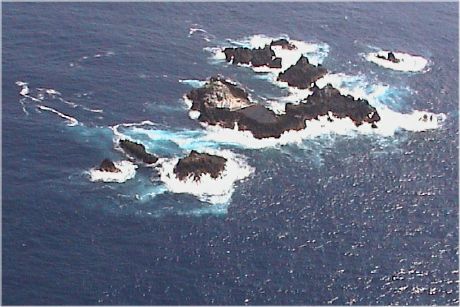Waiting for a second Fairey 17 hydroplane: From 18 April to 11 May, the two navigators waited in Fernando Noronha for the arrival of a second Fairey. As explained in the above summary, this second aircraft could not be unloaded at St. Peter (& St. Paul’s) Rocks and had to be flown to from Fernando Noronha to St. Peter (& St. Paul’s) Rocks and back.
 Fernando
Noronha- St. Peter (& St. Paul’s) Rocks: With 161 gallons, the Fairey
"Portugal" took off at 9:00 after two unsuccessful attempts against a 10 mile
ENE wind. The aircraft maintained about a 70 mile real speed at 1,650 rpm while steering
clear of some pockets of rain. A low speed E wind took over by 10:30. Lat. 0 50 S was
estimated at noon and the aircraft managed to maintain its flying attitude at 1550 rpm. At
13:30 St. Peter (& St. Paul’s) Rocks were spotted from about 15 miles but heavy
rain covered entirely soon thereafter.
Fernando
Noronha- St. Peter (& St. Paul’s) Rocks: With 161 gallons, the Fairey
"Portugal" took off at 9:00 after two unsuccessful attempts against a 10 mile
ENE wind. The aircraft maintained about a 70 mile real speed at 1,650 rpm while steering
clear of some pockets of rain. A low speed E wind took over by 10:30. Lat. 0 50 S was
estimated at noon and the aircraft managed to maintain its flying attitude at 1550 rpm. At
13:30 St. Peter (& St. Paul’s) Rocks were spotted from about 15 miles but heavy
rain covered entirely soon thereafter.
St. Peter (& St. Paul’s) Rocks-Fernando Noronha: The airmen proceeded towards the islets, but continued rain forced them to turn back towards Fernando Noronha just a few miles before they had planned to do so on their return to the refuelling ship Republica located at azimuth 25 N, 70 miles from Fernando Noronha. By 15:25, the rear tanks were empty and the fuel flow was shifted to the main tank with 50 gallons left. At 15:30, the engine began to fail in successive hiccups and, as the sea was relatively calm, the aviators nosed down to an easy landing. While two sharks exposed their fins between the two floaters, Cabral and Coutinho stretched and relaxed over the floaters to discuss: the possible causes of engine trouble, the likelihood of dirt in the fuel carburation system, the extent to which they were drifting away from their position prior to landing, and their chances of continuing voyage to Fernando Noronha. They estimated to be drifting at 1-1.5 miles an hour towards the West. Among failed attempts to restart the engine before sunset, they calculated their position at lat. 1 27 S and long. 30 54 W, that is: 4 miles W and 170 miles (N) from Fernando Noronha. The aircraft seemed to tilt slightly to the right, thus suggesting that the right floater was letting in more water than the left one. At 21:30, the engine restarted and the aircraft taxied southwards over a gentle surf. At 22:25 the engine stalled again with no signs of wanting to start again. The floaters continued to sink and the aircraft would not float much longer. To reduce weight on the rear end of the floaters, Cabral sat on the engine holding on the pipeworks to avoid falling over from fatigue and sleepiness. At 23:45, a light emerged on the horizon, no doubt from an approaching vessel. After an exchange of signaling gun shots, the cargo Paris City on its way from Cardiff to Rio rescued the two airmen. This ship had slightly changed its course having received a radio message announcing a possible problem with the aircraft. By 4:30, the Republica established contact with the Paris City. By dawn the floaters were almost fully submersed and the right wing partly under the water. At 18:30, the Republica arrived, initiating procedures to tow away the Fairey and rescue its engine from the rest of the fuselage. The position given by the Republica’s captain at that point - lat 1 25 S and long. 30 58 W - suggested that the navigators had overestimated their drifting rate.
.